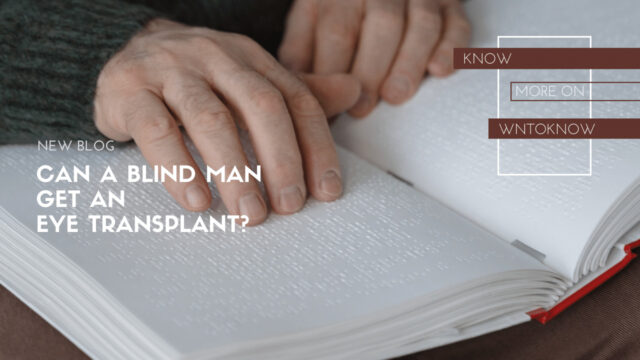Can a blind man get an eye transplant?
A blind man can get an eye transplant if his optic nerve is functioning and there is a reasonable chance of his visual pathway improving as a result of the transplant. He can even get a therapeutic transplant for symptomatic relief from severe pain conditions induced by serious cases of keratitis i.e. corneal ulcer of bacterial/ fungal / viral origin that is uncontrolled in nature. The transplanted cornea can either improve his vision to a reasonable extent or enable him to get relief from excruciating pain. Advanced technologies like keratoprosthetics can further enable an individual the possibility of vision in a prosthetic manner. However, it is important to understand further about blindness, it’s type and the role of transplant in eradicating it before proceeding further.
What is Blindness?
The inability to see and carry-on day to day tasks with best corrected vision is roughly referred to as blindness or vision impairment. The term though, is a broad spectrum one. Blindness covers a wide range of visual disabilities from legally blind and getting benefits for your condition to that caused by uncorrected vision. Some of the important types of blindness are: –
- Complete blindness – You cannot see anything including light rays
2. Curable blindness – Reversible blindness through surgeries/ vision correcting measures
3. Avoidable blindness – blindness preventable through prophylactic measures like timely medical intervention and intake of medications
4. Manifest blindness- Vision very limited from 1/60 visual acuity to mere perception of light
Now coming to the main question- Can a blind man get an eye transplant?
Apart from complete blindness that is completely irreversible, all other 3 forms of blindness can restore vision to a mild/moderate extent through preventative or therapeutic interventions. Eye transplant is one such intervention that is helpful in conditions of curable blindness. A complex procedure that is often incorrectly assumed to involve the entire eye, the transplantation procedure involves the cornea and its layers.
What is an Eye Transplant?
An eye transplant is a corneal transplant that is performed to remove the cornea and replace it with a healthy cornea to restore the transparency of the visual medium. The human eye consists of a lot of components that enable vision in a direct or indirect manner. Among the important components enabling vision are-
a. Cornea – responsible for light entering the eye
b. Aqueous humor – regulates eye pressure along with pathway for light transmission
c. Lens – transmits light by focusing it on retina
d. Vitreous Humor – light transmission regulation with acting as support for the eye structure
e. Retina – converts light into signals that are transmitted by optic nerve to brain and the precursor for vision

Any abnormalities in these structures impact light transmission and affect the vision/quality of vision perceived by an individual. Among the above-mentioned structures, the lens and the cornea are among the only ones that are replaceable. While the lens is removed and replaced with an artificial intraocular lens, the cornea is transplanted and replaced by a natural cornea taken from a healthy donor.
The entire procedure is conducted under anesthetics and it is considered a major surgery. Whether or not the eye accepts the donor cornea or rejects it decides the final outcome. Even then, it can take more than 4 weeks and up to 6 months for vision to be regained. Additionally, vision can be restored only if the remaining components like lens, retina and mediums are in a healthy and working condition. But once successful, corneal transplant can reverse conditions of legal blindness as well when the best vision in the better eye of the person is less than 20/200.
Conditions that Improve With Eye Transplant
- Conditions of perforated cornea that is a result of injury or infection
- Conditions of extremely thinned out cornea that apart from vision loss is a source of immense pain and discomfort to the individual
- Uncontrolled infection that that already affected all the 5 layers and risks affecting the entire eye if not removed on an urgent basis
- Scarring of the cornea post injury, surgery or infection
- Previously failed condition of corneal transplant
- In blindness conditions due to corneal dystrophies like Fuchs, keratoconus and Lattice that have resulted in impaired vision or legal blindness from a very early age
All of these conditions when present in the better eye of the person can be a cause of or lead to blindness. Corneal transplant can enable visual restoration through allowing light to pass through what was previously an opaque surface. This, in turn, can reverse the blindness diagnosis and enable the person to lead a normal life.
What parts of the eye can be transplanted and donated?
It is important to understand that cornea is the only form of transplant that on successful completion restores the vision of a blind person in a direct manner. Being involved in light transmission, this increases the significance of the procedure. But there are peripheral structures as well that are responsible for the wellbeing and transparency of the cornea.
Limbus, conjunctiva and the sclera are responsible for production of tears and mucus along with maintaining the tear film situated directly over the corneal surface.
Also Read: Can Blind People Cry?
Disorders to the conjunctiva and sclera affect the tear film with oxygen supply to the cornea resulting in bacterial infection and dryness induced vision loss and subsequently blindness. In such conditions, eye transplant is conducted using parts of the human placenta and amniotic membrane donated during childbirth to heal them and restore the vision of the individual. Considered an indirect form of individual, conditions of
- Trachoma
- Severe Pterygium
- Vitamin A deficiency induced thinning of sclera
- Traumatic conditions
Are some of the cases in which naturally occurring membranes are transplanted to the peripheral structures to restore the vision of the person.
Risks Cornea Transplant
Non-availability of Donor Cornea
Everyone is eligible for donation of corneal tissues. The blood group, age, eye color and even eyesight of the donor are not going to influence the vision of the recipient. But lack of awareness, religious beliefs and objections of family members after the death of the donor pose the most serious hurdles for obtaining a donor corneal button.
Risk of Rejection
Rejection of the transplanted cornea can occur as a result of post-operative Inflammation, improper use of medications, incompatibility of the immune system with donor graft or sometimes due to systemic complications like diabetes or hypertension. Studies have shown the deeper the layer of membrane transplanted, the increase in the risk of rejection.
Ineligibility for Getting an Eye Transplant
Because of the general unavailability of grafts and increased invasiveness of the procedure, the eligibility criteria for getting an eye transplant is strict. Some of the ineligibility criteria for getting a graft include
– pre-existing conditions of optic nerve damage
– candidates with immunodeficiency conditions causing increased risk of graft rejection
– candidates with repeated history of graft rejection
A Word About Keratoprosthetics
Keratoprosthetics or artificial corneal are the latest improvements in the field of eye transplantation. These involve the use of PMMA based devices with holes for better diffusion of nutrients. Further these devices are equipped with titanium locking for better retention and improved results
Keratoprosthetics is used in blindness conditions where donor corneal cannot be implemented or have high risk of rejection like
- Multiple graft failure
- Steven Johnson’s Syndrome
- Severe burn conditions
In order to acknowledge the best option for cornea transplant in a blind person, it is imperative to consult a best opthamalogist nearby.
References
2. www.aao.org/eye-health/treatments/transplantation-eye
3. www.nature.com/articles/s41536-017-0038-8
4. pubmed.ncbi.nlm.nih.gov/25247377/
5. www.ncbi.nlm.nih.gov/pmc/articles/PMC5381306/
6. www.nhs.uk/conditions/cornea-transplant/
7. www.donatelife.net/types-of-donation/cornea-donation/
8. www.ncbi.nlm.nih.gov/pmc/articles/PMC2781118/
9. www.ncbi.nlm.nih.gov/books/NBK519043/
10. www.aao.org/eye-health/treatments/transplantation-eye
12. www.msdmanuals.com/en-in/professional/eye-disorders/corneal-disorders/corneal-transplantation









![Best and Reliable Foldable electric Wheelchair for Adults and Seniors [2022] Electric Wheelchair for adults and seniors](https://wntoknow.com/wp-content/uploads/2022/04/Electric-Wheelchair-for-adults-180x135.jpg)



![Top 7 FDA Approved Pulse Oximeter [2022] FDA Approved Pulse Oximeters](https://wntoknow.com/wp-content/uploads/2022/05/FDA-Approved-Pulse-Oximeters-180x135.jpg)









![Top 7 FDA Approved Pulse Oximeter [2022] FDA Approved Pulse Oximeters](https://wntoknow.com/wp-content/uploads/2022/05/FDA-Approved-Pulse-Oximeters-238x178.jpg)




